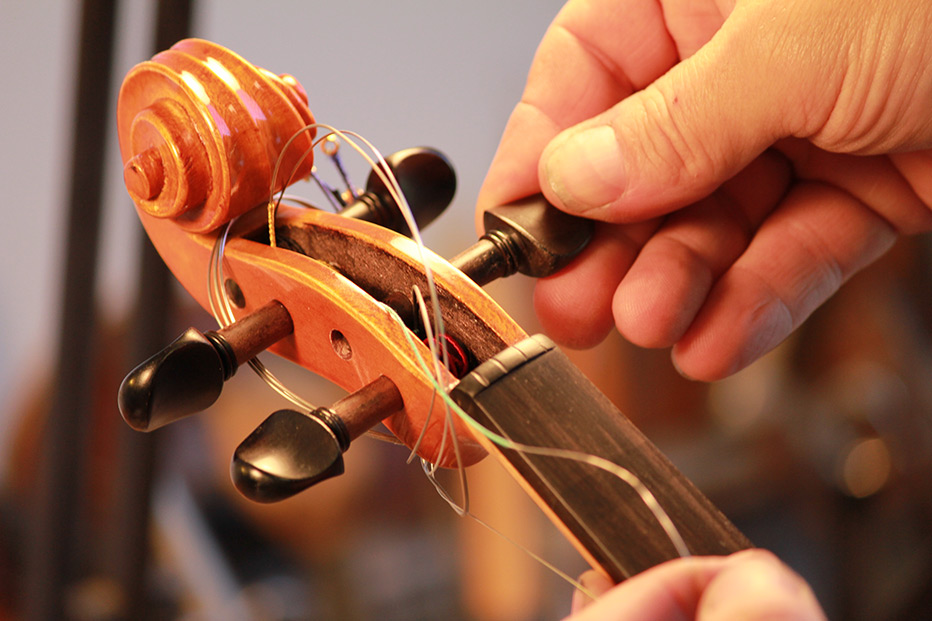April 09, 2015
Star Wars: A Musical Saga


Shop the Star Wars collection today!
A Musical History of Star Wars’ Iconic Sound
While Star Wars is the most successful series of films ever, thrilling decades of audiences and capturing the imagination of kids all over the world, the music that was composed by John Williams for the films has never been overshadowed. This is a rare fete. Only a few films share an identity with their music and are globally known for their music. And most of those are John Williams’ scores. In fact, one of those most memorable original scores by Williams, just an ostinato of bass notes introducing the top movie character of 1975, was terrifying moviegoers in theaters when Williams got the call from “American Graffiti” Director George Lucas to do a new sci-fi project called Star Wars. Williams would win an Academy Award later that year for “Jaws” and his simple theme would forever represent the shark attack and everyday impending doom.
Fast-forward some 40 years and a 2016 headline reads “‘Star Wars’ Soars Past ‘Harry Potter’ with $1.4 Billion at Global Box Office.” The article goes on to explain that the seventh installment of the Star Wars series, “The Force Awakens,” made $59 million on just the 17th day of release but that had been enough to put it over the top in the battle against a Harry Potter film for 6th best. Interestingly both these films were scored by John Williams as were most of the films ahead of them.
John Williams had already been nominated for 11 Academy Awards when he was asked to do the Star Wars soundtrack. He worked with Steven Spielberg often, and the director recommended him to Lucas for the Star Wars project when he heard Lucas wanted to use classic symphonic music from the past. Williams was classically trained as a pianist but was from a family of percussionists. Percussion is an important part of the Star Wars music. You can hear the influence of his father and brothers, all professional percussionists, as much as you can Tchaikovsky, Wagner, Holst, Prokofiev, Stravinski and Chopin.
Williams’ style on the Star Wars soundtrack and many others is essentially a form of Neoromanticism, inspired by the late 19th century’s large-scale orchestral music. Some say his Star Wars music sounds like Holst conducting a Chopin arrangement. One music critic nailed it calling the style “badarse triumphalism.” One of Williams’ tasks was to write music that would be the backdrop to the movements of an indestructible and evil army. Unlike Wagner, Williams’ army was fictitious, but like Wagner, he held nothing back, and the music is as aggressive and as oppressive as Die Valkyrie, which was the goal.
No one expected the soundtrack to become the most awarded ever and to be Hollywood’s most iconic music, but in 2005, the American Film Institute named the original Star Wars soundtrack as the most memorable score of all time for a US film. It has been preserved by the Library of Congress because it is “culturally, historically, or aesthetically significant.” It is forever part of our American history.
The original Star Wars film, while it was the first produced, fits into the series as the 4th episode of 9. But it is important to remember that it was the first, especially when looking at the music. This is because Williams borrowed a technique from Tchaikovsky and Wagner called leitmotif. This is when a recurrent theme throughout a musical or literary composition, or, in this case, the whole series, is associated with a particular person, idea, or situation. This is why we hear parts of songs from the first movie intermingled in with every other soundtrack. When a character with theme music interacts with another character with theme music, both themes may be played while they fight or kiss or whatever. So for this reason, we will start with the original Star Wars film, now called Star Wars, Episode IV: The New Hope.
Star Wars Episode IV: The New Hope
There is no substitute for the original Star Wars film or soundtrack. Every installment since the first, while featuring acclaimed new music, is a reference to the first. There are songs on many of the soundtracks that are more popular with the hardcore fans than the original, but as a complete album of music, the 1977 original Star Wars soundtrack is classic and is the masterpiece. We are introduced to the Force, the Empire, the rebels and every significant character with brilliant theme music that helped us establish our view of these now-iconic figures. The music was so popular that the title theme was covered by the dance band MECO. The disco dance version became the number one hit in America and was popular in clubs for years.
Leitmotif appears right away in the latter parts of the very first episode. “The Jedi Theme” is repurposed at the end as a triumphal march. “Darth Vader’s Theme” is used throughout as the dark character reappears. Interestingly, “Luke Skywalker’s Theme” was so popular that it became the series’ main thematic music, opens each film and is referenced in most action scenes throughout. In the song’s debut, while the iconic opening text sets up the story, Williams said he used a brilliant register of the trumpets, horns and trombones in order to have a blazingly brilliant fanfare to open the score.
Theme music, like characters, developed and grew over the course of the film and series. The Force is given a dedicated theme that arises whenever its mystical powers do, from the early contemplation by Luke to the destruction of the Death Star. The original Star Wars soundtrack is so seamless and referential that one might have been surprised to see that each song had its own name when they bought the album in 1977. But it’s important that they did, as each would reappear in many ways throughout the series.
The original soundtrack and all subsequent soundtracks until the 7th installment, The Force Awakens, were performed by The London Symphony Orchestra with John Williams conducting. The original was recorded in eight sessions at Anvil Studios in Denham, England. Herbert W. Spencer orchestrated the music for this and the next two films, The Empire Strikes Back and Return of the Jedi.
Perhaps the most memorable scene from the original movie is the “cantina scene”, where myriad aliens mingle and drink exotic intoxicants until an intergalactic brawl ensues, all to the unique sound of a band identified in later references as Figrin D’an and the Modal Nodes. The cantina was important, because while the story was about only a dozen characters or so, the universe it affected was massive and was reflected here at the cantina. For this scene, Williams pulled from his jazz background trying to evoke the 1940s but sounding “both alien and yet familiar at the same time” according to his writing on the topic. This is the only diegetic music (played by characters) in the film, so it sounds nothing at all like the rest of the soundtrack and includes no leitmotif references.
While the film is dark and the music evocative of evil, regret, war, bitter victory and planetary explosions, the movie closes with the bright and hopeful “The Throne Room.” This inversion of tone references the rest of the soundtrack but in a light and positive direction, allowing the moviegoer to disengage and segue back to their real lives. Many fans did not make that transition smoothly and returned day after day to see the movie again and again in what, at the time, was a unique and new phenomenon.
Star Wars Episode V: The Empire Strikes Back
The original Star Wars movie introduced us to the “Space Opera” and the follow-up, Star Wars, The Empire Strikes Back started the blockbuster sequel trend that lives on today. Again, this is the second movie produced but the 5th in the chronological tale. The movie and the soundtrack were huge hits, and Williams was allowed to dip even deeper into the evil soul of Darth Vader with “The Imperial March – Darth Vader’s Theme”, so powerful and iconic that it is often mistaken for the Star Wars overall theme music from the first film. “The Asteroid Field” remains a popular download and feels like a frenetic trip with Han Solo and the Millenium Falcon through an asteroid field with the Empire’s ships on your tail. “Yoda’s Theme” builds from a flitting of light strings to a full crescendo, strong and confident with benevolence – the qualities of a master Jedi.
Star Wars Episode VI – Return of the Jedi
“The Victory Celebration” is the most memorable song of the third soundtrack, both triumphant and mournful at the same time. It closes what was to be a trilogy and did so perfectly as the audience thought they had witnessed the end of the greatest movie series ever. A male choir is introduced for the first time in the dark and foreboding “The Emperor Arrives” and the evil is tangible. “Yoda’s Theme” returns as a gentle farewell after the popular character’s death in a brilliant leitmotif.
Star Wars Episode I: The Phantom Menace
Fans were excited but skeptical of the “prequel” to the original Star Wars with all new characters they did not know, but the inclusion of John Williams to score the music kept some connection to the original. The soundtrack is celebrated as one of the best in the series. The most downloaded Star Wars song ever on Spotify is a song that the general public may not even know but is the overwhelming favorite of Star Wars purists. “Duel of the Fates” occurs during the climactic Darth Maul/Obi-Wan/Qui-Gon duel. It features a choir, brass, and strings, in an ever-growing battle of good and evil. One critic says, “This song never takes sides.” It has no association with a bad or good character and giving no nod to either faction of the Force. This is done with the use of various instruments echoing others in pairs. The choir chants in Sanskrit and then strings and violins mimic each other, followed by clarinet, harp, French horn and trombone echos. It’s a battle of instruments really. The tuba and trumpet follow some more strings. The build is gradual, as the light saber fight grows more intense until the fateful climax. And then timpani, bongos and strings quietly bring us down.
Star Wars Episode II: Attack of the Clones
“Duel of the Fates” returns brilliantly in the Attack of the Clones installment of the series during Anakin’s search for his mother. But the highlight of this soundtrack was, without a doubt, the larger-than-life love song “Across the Stars”. This story of forbidden love and all of its associated emotions is told beautifully by Williams as Anakin and Padmé, a galaxy apart, long for each other. “Kamino Theme” is as good a rainy day theme as any. It’s always raining on Kamino.
Star Wars Episode III: Revenge of the Sith
This film features what is considered the best light saber battle of all the films although some attribute that accolade to the music from the scene. “Battle of the Heroes” references nearly every other great Star Wars tune at that point and reinvents itself as a stand-alone arrangement that is loved by all Star Wars fans. Originally called Darth Vader, the song reaches from sadness to exhilaration and from loss to triumph and back in a mastery of the form we now know as “Star Wars music.” “Anakin’s Betrayal” evokes emotion from the true fan as Anakin betrays his family, goes to the “Dark Side” and becomes Darth Vader, a moment the audience has been anticipating now for over 20 years. One of the most Wagnerian arrangements in the series is heard in this installment as General Grievous steps out of his spacecraft and is greeted by millions of bodyguards, battle droids, and soldiers. It feels like the old movie clips of World War II era tyrants.
Star Wars Episode VII: The Force Awakens
The faithful were still clamoring over the directorial transition from Star Wars Creator George Lucas to the younger but much accomplished J.J. Abrams when the first ever live performance from The Force Awakens was performed by the United States Army Field Band at the Midwest Clinic International Band and Orchestra Conference in Westmont, Illinois, sponsored by Music & Arts. A week later the movie opened to record audiences, and John Williams’ seventh Star Wars soundtrack debuted at number five on the Billboard 200.
For the first time, a Star Wars score was recorded in the United States and without the London Symphony Orchestra. Williams worked with members of an elite freelance orchestra assembled previously to record his more recent scores. The new location and configuration allowed the soundtrack to be recorded over several months in Los Angeles and for the film’s editorial and special effects teams to contribute. The performance was conducted by Williams and Gustavo Dudamel,
Music Director of the Los Angeles Philharmonic.
With new characters dominating the early screen time in “The Force Awakens” we are treated to a new sound in the Star Wars series – the piano. Rey and Finn are introduced with a humble and revealing chord progression as we see her scavenging for metal scraps and machine parts to get by, and we witness him stepping onto the battlefield for the first time as a fresh young stormtrooper. The score befits the “All Quiet on the Western Front” moment until we are introduced to Kylo Ren, the new villain, striding triumphantly on the same battlefield to a rich new sound utilizing the full orchestra and inspired by “Darth Vader’s Theme”, just as Kylo Ren is inspired by it’s namesake and his Grandfather. We learn that Kylo Ren is the son of Han Solo and Princess Leia as the music hints of “Han and Leia’s Love Theme” from the original trilogy. When the two original stars are united, the theme is full on. Older patrons are returned 40 years to their youth while new fans are delighted by the music for the first time.
Of note on this soundtrack are also “Maz’s Counsel”, a softer tune with long cello strokes that eventually morphs into the familiar “The Force Theme” is a great musical moment. Also “March of the Resistance” is an uplifting and grand arrangement like “The Imperial March” but altogether different. Missing in this episode is a large amount of leitmotif and references to the original main theme music, perhaps signaling a change in the music and directorial objectives. This movie is introducing the story to a brand new audience and will, if successful in the long term, excite and captivate another generation.
The famed cantina scene is reinvented in this episode but was scored by guest composer and Broadway and rap innovator Lin-Manuel Miranda. The tune is quirky and different from the rest of the soundtrack, which was the intention, but it is far less significant to the plot this time around and is not included on the commercially available soundtrack.
Star Wars is the most known soundtrack in film history but it would be impressive just to be the most known in John William’s discography. His collection now includes E.T., Raiders of the Lost Ark, Harry Potter, Close Encounters, Saving Private Ryan, Schindler’s List, Superman, Angela’s Ashes and Jurassic Park among many others. The 1950 graduate of North Hollywood High School has scored nine out of the top 20 movies of all time. He has penned the theme music for four Olympics. As of this publication he has 49 Academy Award nominations, just one less than Walt Disney, and he’s still going strong. He has won five Oscars along with three Emmys, four Golden Globes, 22 Grammys, and Lifetime Kennedy Center Honors.
Williams’ Grammy Awards have been won against composers for film and composers from the general music world. The debate will, perhaps, always continue as to whether he belongs in the same paragraph with the greats he was inspired by or even Bach and Beethoven. Even if the three are not comparable, Bach ruled the Baroque style and Beethoven dominated the Romantic Era no more than John Williams owns the Neo-Classical genre. And Williams has had far more commercial success and popular acclaim than either of what are considered to be the top two composers the world has ever known. So many more people have seen the Star Wars films than have attended classical music performances over the same period, that he must, at least, be considered representative of our time on the list of greats, wherever it is eventually decided that our “era” belongs in the annals of musical history.







